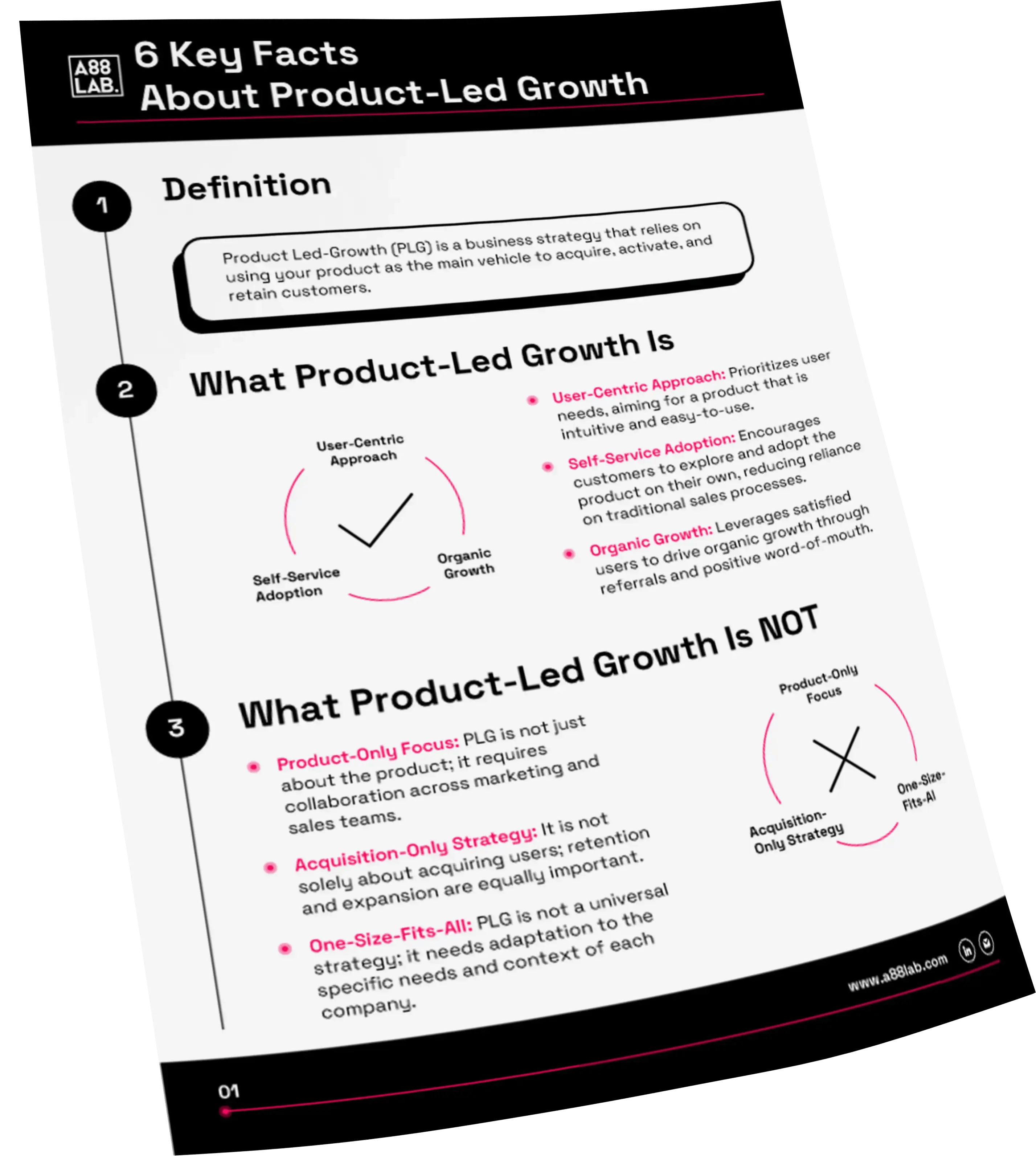Introduction to Product-Led Growth (PLG)
Deciding which growth strategy is right for your business isn’t a walk in the park. You have to take into account the pros and cons, as well as the specific nuances of each strategy. If you were thinking about adopting product-led growth, then this is the place to find out what makes it stand out from other strategies, and why it is important for B2B SaaS.
What Is Product-Led Growth?
Product-Led Growth (or simply PLG) is a growth strategy that centers around the product, relying on its inherent value and usability to drive customer acquisition, retention, and expansion. PLG represents a shift from traditional marketing and sales-oriented approaches to a model where the product itself becomes the primary driver of business growth.
Assuming you have already encountered and used various growth strategies, you are well aware that each is based on a core principle. The two main ones for product-led growth are a user-centric approach and encouraging adoption.
Since product-led growth is user-centric, you design the product with the end user in mind. This approach also entails a constant value delivery of the product, which will become the driving force behind customer engagement. While other more traditional growth strategies like demand generation often rely on marketing campaigns or sales tactics, product-led growth puts the user front and center by designing a product that is intuitive, self-explanatory, and designed to deliver value.
Before discussing how you can encourage adoption, you must first understand what that term means. Product-led growth focuses on more than just customer acquisition, but also on retention, and expansion. Hence, adoption is the second core principle of this growth strategy. It accomplishes this by ensuring active product usage, which is achieved through intuitive onboarding and providing the users with detailed educational resources.
Now that we’ve answered what is product-led growth, we can focus more on what you’re probably here for: What is the purpose of PLG in a B2B SaaS context?
Why Is Product-Led Growth Important for B2B SaaS?
On paper, all growth marketing strategies look like they are THE solution to your problem, but the reality is often different. That’s why, before adopting any strategy, you must evaluate the business goals, your resources and the overall company strategy, to avoid misaligned expectations. When compared to other strategies, product-led growth stands out, among other things, with its emphasis on letting the product itself drive customer adoption.
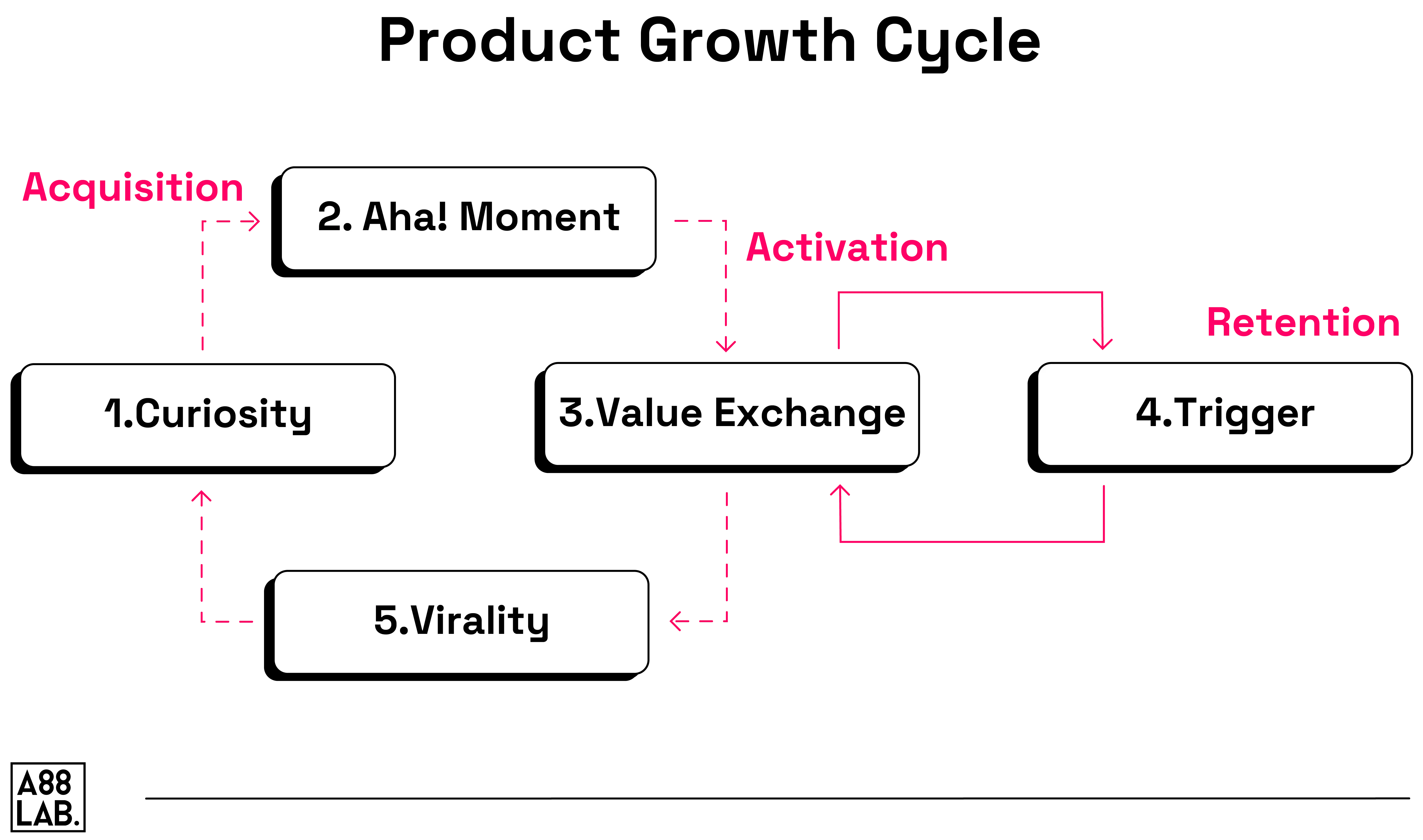
This last part is the key because it entails several benefits for the B2B SaaS industry. First, product-led growth, especially PLG SaaS, has no other channel to fall back on when the going gets tough. There is no organic marketing campaign to save the day, nor a database of leads to email or cold call. You must ensure that your users can derive the most value from your product at any given stage of the buyer’s journey.
If that last part sounded scary, it should not! Adopting a product-led growth strategy always translates to shorter sales cycles that directly impact the customer acquisition costs (CAC). If we compare product-led growth vs sales-led growth, which we’ll do later on, that will be one of the conclusions. Because the product itself does the selling, you’ll be essentially bypassing the many stages of the sales funnel, so no costs for SDRs and BDRs (if you don’t have another enterprise version of the product of course.)
The final aspect you must consider when thinking about PLG SaaS is the potential for viral growth. When you think about it, it’s pretty simple: you make a product that will give the most value to your customers during the entire buyer’s journey. If you truly manage to produce the most value possible, they will be satisfied with your product. Satisfied customers often share their satisfaction with friends, coworkers, or, even better, people online.
A decent amount of word-of-mouth buzz will lead to viral growth. Since the B2B SaaS market is, at times, a “dog-eat-dog world,” word-of-mouth and virality will tremendously impact the customer’s reception of your product, without needing to spend a lot of resources on communicating its value. In fact, with PLG SaaS, the product will do that for you. All you have to do is reap the benefits, and believe us when we say there are plenty more.
Product-Led Growth for B2B SaaS
Speaking of the benefits of product-led growth, we must mention that we will discuss those in a B2B SaaS context. While we are sure this growth strategy can be applied in other industries, we will focus on this specific industry because it’s our primary expertise.
Impact on Customer Experience and Retention
You have probably heard the phrase, “The customer is the king.” Yes, it’s a cliché, but it also holds true. In the case of product-led growth, this saying can be considered as one of the driving forces of the strategy. With that being said, one of the many ways in which companies try to satisfy their customers is by improving their experience.
When you consider the ways in which you can make the customer experience better, you have to take into account that product-led growth relies on self-service channels to attract customers. This may seem too obvious, but it’s a key aspect of why product-led growth impacts the customer’s experience in a positive manner. By giving out freemium versions or demos (which we will discuss later on), the customers can see for themselves what your product can do for them. Elena Verna is providing a great explanation about the importance of PLG in the below video.
If your potential customers can use some version of your product prior to committing to buying it, you do not need to use other channels to sway them your way. This reliance on the product doesn’t simply stop at customer attraction; it also extends to customer retention. By that point, you have acquired a customer, so you have to make sure your product provides the most value it can, so the customers stick around and don’t look for any alternatives.
Reliance on self-service channels and the product itself will inevitably equal improved user experience. Oftentimes, it’s not about having the most features. It’s about striking a balance between providing the essentials and the added value your consumers can’t find elsewhere. If the customer is king, they deserve a royal experience.
Scalability and Sustainable Growth
Up until this point, we only discussed the benefits of product-led growth from the customer’s point of view. Let’s focus on what product-led growth does for B2B SaaS companies and how it can help with some of your internal pain points.
Since this growth strategy is, well, product-led, there is little to no dependency on human interaction from the company’s side, leading to faster scalability. As a result, you will not have to tweak any campaigns or chase any dead leads. If you are sure your product is up to date and provides the most value, you don’t have to worry about onboarding team members. You need to make sure you can scale it correctly, leading to sustainable growth.
Sustainability and sustainable growth may raise the most doubt before starting a business or adopting a growth strategy. In the case of product-led growth, the product that provides the most value can rely on something other than a large marketing and/or sales team. By making sure your product is the best it can be, you will start growing in no time, and in a very sustainable manner.
Cost-Efficiency and Improved Customer Acquisition
When discussing benefits of any kind, let alone benefits of product-led growth, financial benefits are almost always the most common topic. In terms of product-led growth, profitability is what steers companies in its direction.
If you really think about it, employees are the company’s largest investment. They are the driving force of the company’s mission and vision, and as a result, they need nurturing, both in financial and educational terms. Traditional marketing strategies rely on large sales and marketing teams to promote their offering. As you may have already deduced, large teams lead to large investments, which lead to spending more $$$.
Promoting your product is done to get customers; there is no rocket science behind it. As a result, customer acquisition is often the highest cost since it requires having more sales and business development employees. That is, if you use something other than product-led growth.
Product-led growth is an inherently inbound strategy, meaning that it’s focused on nurturing customer relationships by providing the most value possible. By using PLG, you’re remedying the high acquisition costs associated with other growth strategies.
Understanding Product-Led Growth Framework
While sales-led growth and marketing-led growth have been around for a while, product-led growth is still a fairly new growth strategy, mostly used in the tech and SaaS industries. As a result, there are several different aspects that differentiate it and make it a unique strategy, especially if your goal is to achieve hyper-growth, without expanding your workforce.
How Product-Led Growth Differs From Traditional Growth Models?
Assuming that you have already encountered and used growth strategies of various types, after a while, they may all start to intertwine, sound similar, or look exactly alike. Let's have a look at what separates the product-led growth framework from its counterparts!
Product-Led Growth vs. Sales-Led Growth
As the name suggests, sales-led growth heavily depends on the sales team's capabilities. This reliance extends across customer acquisition, retention efforts, and revenue growth. In contrast, product-led growth takes a distinctive path by making the product the primary driver of these crucial aspects. As a result, you need to truly understand your business if you want to make the right decision between product-led growth vs. sales-led growth.
TBC.webp?width=900&height=532&name=PLG%20vs%20Product%20Centric%20Growth_infographic-11%20(3)TBC.webp)
Product-Led Growth vs. Marketing-Led Growth
Marketing-led growth leans on traditional marketing channels, primarily using content marketing, SEO, and PPC to fuel customer acquisition, retention, and overall revenue growth. On the other hand, product-led growth breaks away from this mold. When it comes to product-led growth vs. marketing-led growth, the former emphasizes self-service channels, such as freemium models and demos, to attract and retain customers.
Related article: Product-Led Growth vs. Marketing-Led Growth
Product-Led Growth vs. Product-Centric Growth
Distinguishing between product-led and product-centric growth requires quite a bit of understanding. While product-centric growth also places the product at the forefront, it does so coupled with traditional marketing and sales strategies. Product-led growth, however, places great importance on the self-service aspect, using freemium models and demos as primary tools for customer acquisition. This distinction positions PLG as a holistic approach where the product takes center stage, reshaping the conventional product-centric growth models.
Product-Led Growth as a Go-To-Market (GTM) Strategy for SaaS
The adoption of product-led growth marks a significant shift from traditional go-to-market strategies, especially in B2B SaaS. When adopting product-led growth, you will use it as a guiding force, as the product shapes your growth strategy.
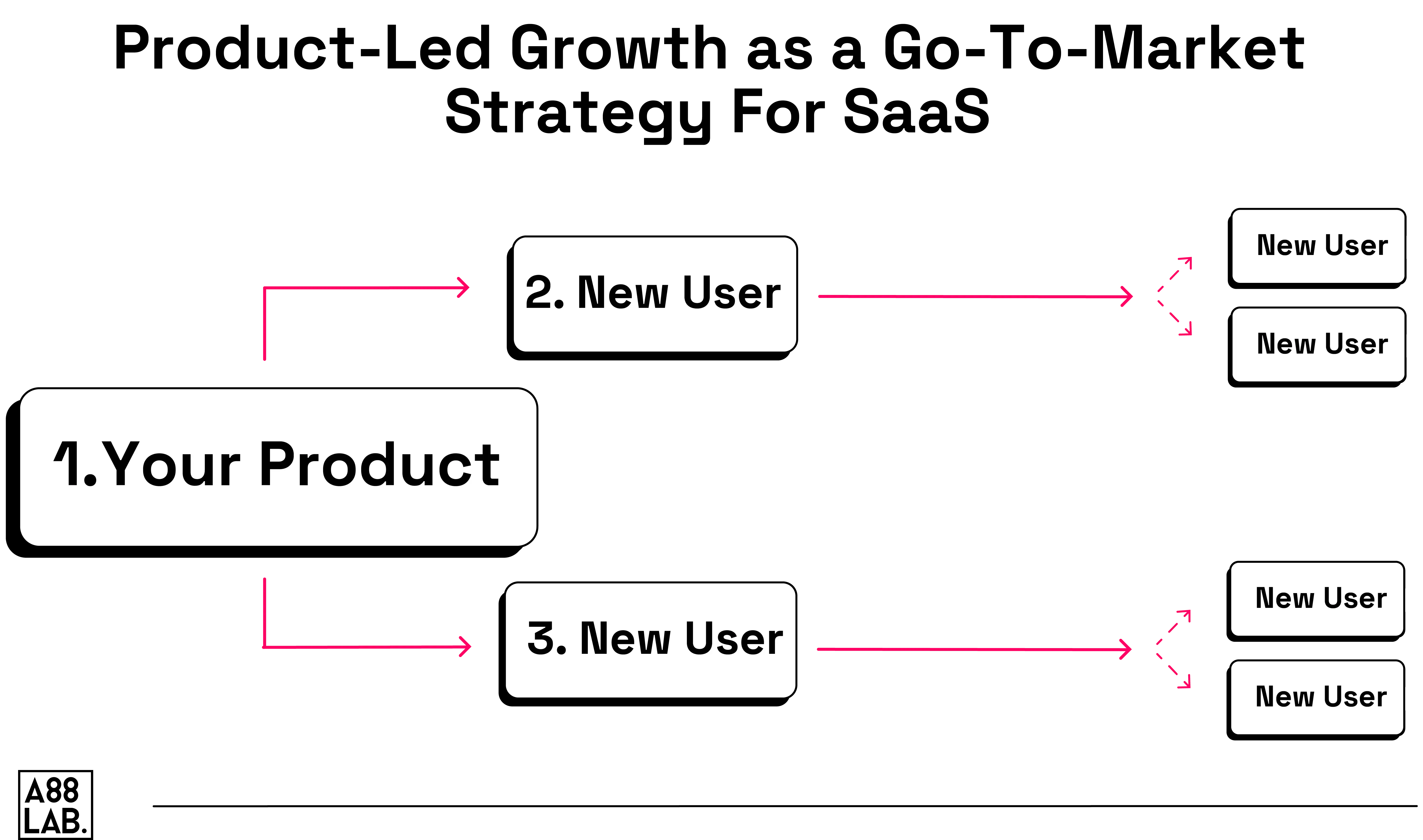
Leveraging freemium models and self-service channels becomes crucial for effective market penetration in the B2B SaaS industry. A product-led GTM encourages SaaS providers to rethink their approach, aligning with the preferences of modern users who seek hands-on experiences and value-driven solutions.
Product Qualified Leads (PQLs) in Product-Led Growth
Just like there are Marketing Qualified Leads (MQLs), there are also Product Qualified Leads (PQLs). While in essence, they share some similarities, there are also some distinctions, which, in turn, highlight the importance of PQLs.
Evolution From MQLs to PQLs
Transitioning from traditional Marketing Qualified Leads (MQLs) to Product Qualified Leads (PQLs) signifies a switch in how businesses identify and engage with potential customers. MQLs usually involve individuals interacting with a company's marketing content, representing a stage in the traditional sales funnel. On the other hand, PQLs represent users actively using the company's free services, demonstrating a more hands-on and product-centric engagement.
This evolution is not merely a semantic change, but a strategic realignment. While MQLs may engage with various marketing activities, PQLs directly engage with the product itself. This shift highlights the importance of product interaction as a key qualifier in the PLG framework, emphasizing the value users derive from the product.
Limitations of the Traditional MQL Model
In the B2B SaaS context, the traditional MQL model comes with limitations. When it comes to B2B decision-making, it’s rarely just one person deciding to swipe a credit card on a new software, posing a challenge for strategies reliant on individual engagement. Additionally, the finite number of companies seeking specific solutions means that aggressively scaling MQLs can lead to diminishing returns over time.
Recognizing these limitations is key for businesses that are in the B2B industry. Product-led growth offers an alternative approach, focusing on user interaction and product value, aligning more effectively with the collaborative nature of B2B environments.
Importance of PQLs in Tracking Customer Journeys
Within the product-led growth framework, the tracking of customer journeys gains new dimensions with the incorporation of PQLs. Going beyond traditional lead tracking, PQLs serve as a metric to monitor, analyze, and enhance the entire customer journey. Insights derived from PQLs show user interactions with the product, enabling businesses to tailor strategies for improved user experiences, increased conversions, and sustained success with customers.
As companies prioritize customer-centric models, the role of PQLs becomes key in understanding and optimizing the delicate paths customers take throughout their engagement with the product.
Implementing Product-Led Growth
By now, you have a decent understanding of what is product-led growth, at least we hope so :). However, you should also know how to put this new-found knowledge into practice, and be able to turn your business into a product-led growth company. While product-led growth may seem like a foolproof way for your business to thrive, its proper implementation relies on several factors. Even though with PLG, success may seem guaranteed, it’s far from a cookie-cutter strategy. For product-led growth to work, you need to make several key changes in your business. Let's explore them:
User Onboarding
No matter how user-friendly your product is, you have to give them an opportunity to ease the learning process. Offer them a guide-through by focusing on your product’s features, functionalities, and the nitty-gritty details. Navattic got this on their homepage, they have a detailed demo for their app, as well as for individual products.
%20Approach_Screenshot.webp?width=1600&height=900&name=Shifting%20Your%20SaaS%20to%20a%20Product-Led%20Go-To-Market%20(GTM)%20Approach_Screenshot.webp)
Freemium Models
If you prefer a hands-off onboarding approach, freemium models are the way to go. We will discuss each model separately, but to get the gist of it, they will give the users a chance to familiarize themselves with your product for a limited time period.
Doing so will allow them to understand whether or not your product fits their needs. HubSpot has been a champion of the freemium model since its launch. The platform offers free tools without paying a dime, while supporting the user onboarding with free courses and perfect user experience.
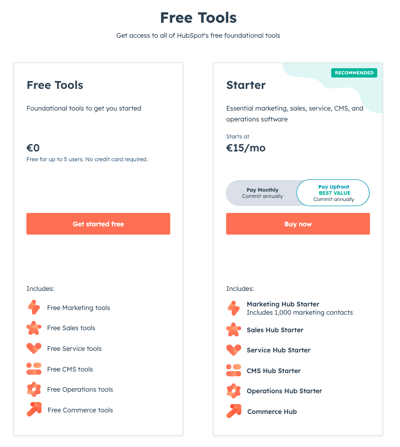
Pricing Model
Whether you decide to go with guided user onboarding or a freemium model, don’t forget to adapt your pricing model. We have a separate section dedicated to this, but let’s start with a small spoiler: product-led growth pricing models differ from the traditional ones.
Semrush has been synonymous with diversified pricing models:
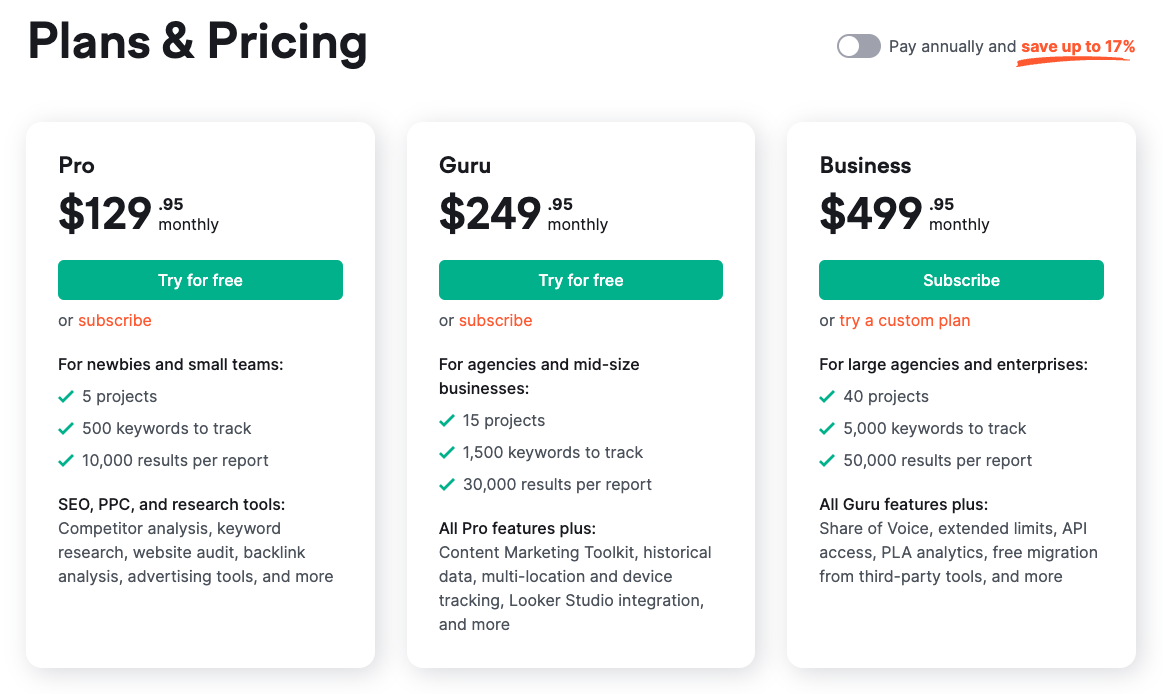
Making Organizational Changes for Product-Led Growth Adoption
The shift towards a product-led growth strategy requires quite a few organizational changes. Opting for a smaller marketing and sales team reflects the reduced dependence on traditional outbound strategies. You need to get a more agile, tech-support-focused team, ensuring immediate and effective assistance for users navigating the product.
Additionally, if you adopt a higher degree of technology across the organization, you’ll enable employees to align effortlessly with the product-centric aspect of product-led growth. This organizational restructuring sets the stage for an environment that thrives on responsiveness, adaptability, and a shared commitment to the success of the product-led approach.
How to Establish a Product-Led Approach
Implementing product-led growth is one thing, but establishing a product-led approach is a different ball game. This section will give you insights into what you need to do if you want to establish a product-led approach in your B2B SaaS company!
Identifying and Establishing Your Product's North Star Metric
One of the most critical metrics you need to keep in mind when establishing a product-led growth strategy is the North Star Metric. In B2B SaaS, retention plays a crucial part. If we were to define the North Star Metric, it would relate directly to customer retention. More precisely, this metric is the minimum set of actions that users complete when deciding whether or not to continue with long-term usage of your product.
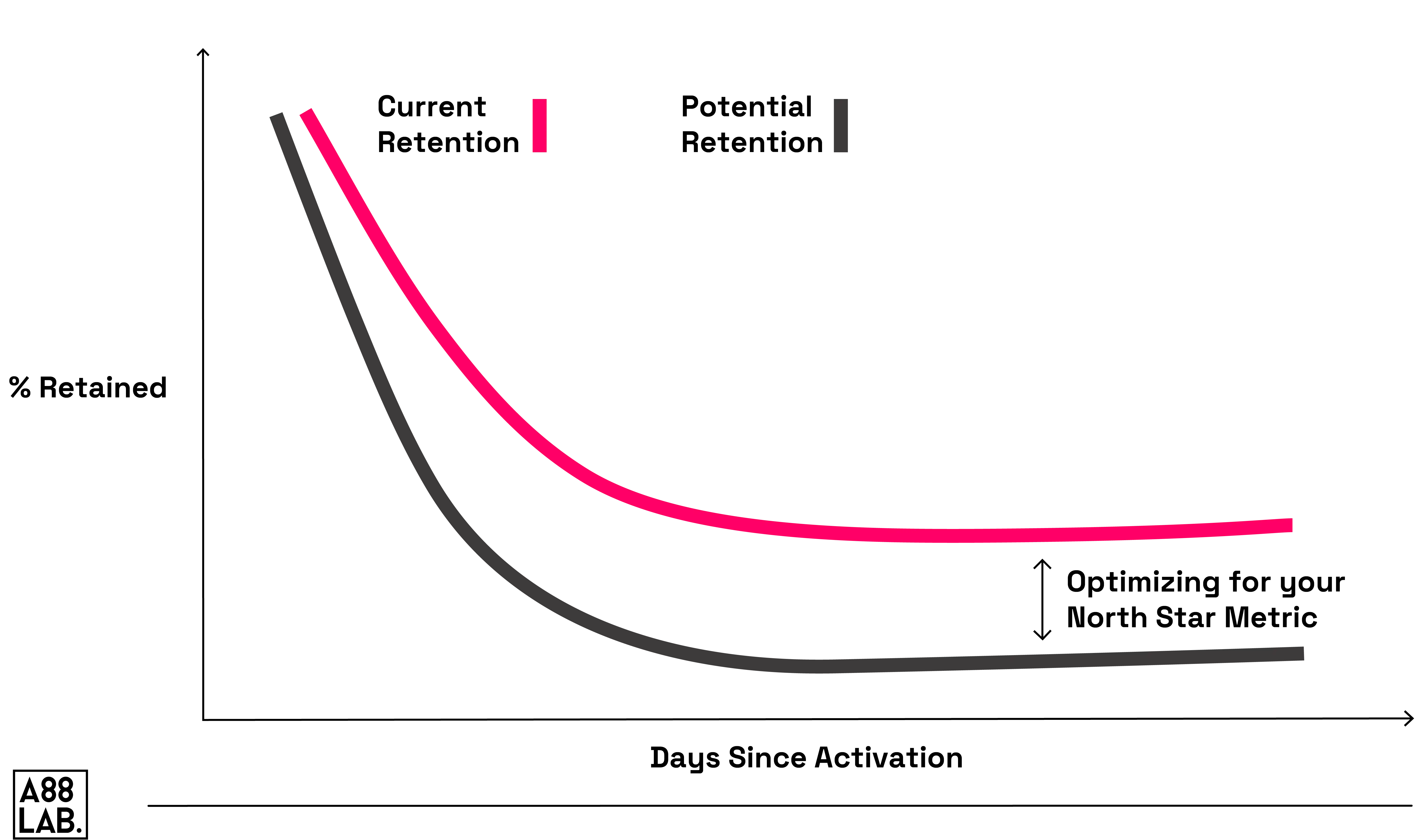
This metric serves as a guiding light for identifying specific behaviors that, when achieved, result in higher rates of retention and conversion. To start, define your onboarding metric, the one that will signal that the user has started using your product. We can also call it your product’s promise.
Next, you must know what physical steps your user makes to become activated. Following this, you will also need to calculate the length of time of each of these steps. The final step would be to find the common conversion activities between your users, which will lead to an exact definition of your product’s North Star Metric.
Prioritizing Growth in Product Initiatives
Product-led growth, marketing-led growth, sales-led growth, and product-centric growth. Even before we outlined their differences, you probably noticed the one thing they had in common: they all focus on growing your business.
Related Article: Scaling SaaS With Marketing-Led Growth and Product-Lead Growth
However, if you are an entrepreneur or you work in a start-up, you know how difficult it’s to actually grow a business. It involves understanding your target market, having a well-defined ICP, and succeeding in untangling yourself from the repetitive, yet important daily tasks.
If you are stuck in terms of growth, use these key points as a starting point:
- Make a plan: you have heard this before, but if you fail to make a plan, you plan for failure. Write down what you want to achieve with your business, and stick to it.
- Define your goals: based on your plan, set SMART goals; Specific, Measurable, Attainable, Relevant, Time-Bound. Each of your activities should be relevant to these goals.
- Product-plan balance: make sure that the product you create is also created for growth. While it should answer customer needs, it should not stop there; it should constantly grow.
Prioritizing growth entails constant innovation, adaptation, and feedback integration. As your product evolves, so should its ability to meet the needs of the growing number of users.
Using Behavioral Analytics for Success Measurement
Finding success with a product-led strategy is largely dependent on understanding user behavior. If you think about it, it comes down to how the users interact with your product: do they find it valuable, do they want to commit beyond a freemium plan, or do they see a better alternative on the market? One way to measure user behavior is through behavioral analytics.
Behavioral analytics uses a combination of big data analytics and artificial intelligence on user behavioral data to identify patterns and trends to enable useful action. You can incorporate behavioral analytics into your product-led growth strategy by implementing tools that will capture, analyze, and derive insights from user interactions. By doing so, you will have a better understanding of customer journeys, highlighting pain points, and areas for improvement.
Using behavioral analytics within a product-led growth strategy can certainly be of service, since you will get a better understanding of your user behavior, leading to improvements of your offer. In essence, behavioral analytics can be the compass that will guide you on your product-led growth success.
Understanding, Communicating, and Delivering Product Value
In any industry, especially in B2B SaaS, simply having a good product isn’t going to cut it. You must also know everything about your product and the value that it will bring to your customers. In order to do so, you need to have a deep understanding of your offer and it’s value, so that you can effectively communicate and deliver it to your customers.
Understanding Your Product's Value Proposition
Your product’s value proposition serves as the initial point of contact with your potential customers. This statement will help them understand what your product can do for them, what it's about, and why it’s better than the competition. In a product-led growth strategy, the value proposition shouldn’t simply state the aforementioned things; it should also resonate with the user, just enough to make them sign up for onboarding or a freemium plan.
Communicating Value Effectively to Customers
You don’t need to be a rocket scientist to know that if you don’t effectively communicate your product’s value to your customers, you might as well throw your product in the thrash. When it comes to communicating value, product-led growth differs from other strategies with one crucial aspect: the product is the only channel that will do the job.
We previously discussed this, but when it comes to product-led growth, you don’t rely on marketing campaigns or a leads database to communicate your product’s value. For better or worse, the product is the star of the show. That is why you must be sure that the self-service aspect of your product is like a fine-tuned instrument, and your customers will get to play it via freemium offerings or demos, or you’ll conduct them through user onboarding.
Ensuring Consistent Delivery on the Promised Value
Consistency is key, and when it comes to product-led growth, this is true for several aspects. In this part, we will be focusing on value delivery. In order to remain consistent with delivering on the promised value, you have to be aligned both internally and externally.
When it comes to internal alignment, set up processes that maintain the quality and the effectiveness of your offer. This will entail keeping your employees in the loop, which is crucial in the PLG context since they need to be prepared to answer all sorts of questions during user onboarding. Regarding the external alignment, keep the self-service channels up to date at all times, and to do so, you must understand your users. Wes Bush sums this up by giving you these five questions:
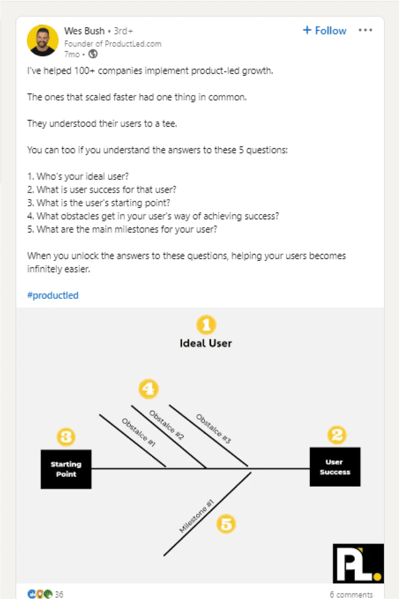
How to Measure Product-Led Growth?
On paper, it seems as if you adopt product-led growth, you’ll have guaranteed success. However, in order to achieve success, you must first measure the progress. Like with every other growth strategy, there are several metrics to track when you measure product-led growth.
Acquisition Metrics
Understanding your customer's journey is one of the main aspects of a well-adopted product-led approach. Customer Lifetime Value (CLV) is the lighthouse that guides your strategy, highlighting the potential long-term value each customer brings.
When harmonized with Customer Acquisition Cost (CAC), businesses gain clarity on the financial viability of acquiring customers, a fundamental aspect of product-led growth success. Striking the right balance between these metrics ensures sustainable growth, providing a solid foundation for a thriving product-led growth strategy.
Customer Acquisition Cost (CAC) reflects the expenditure involved in bringing new users on board. It’s an important metric in the PLG framework, representing the financial investment required to convert potential users into satisfied customers. Calculating CAC alongside CLV allows businesses to measure the efficiency and profitability of their acquisition strategy. For a successful product-led growth strategy, achieving a positive ratio between CLV and CAC is key.
Time-to-Value (TTV)
Time-to-Value (TTV) is the heartbeat of product-led growth, measuring the pulse of user onboarding. It signifies the duration it takes for users to grasp the inherent benefits of your product, marking their "aha" moment. A shorter TTV is the benchmark of an efficient onboarding process, enhancing user satisfaction and reducing the risk of early avoidance.
In the product-led growth context, where user experience is key, TTV becomes a vital indicator of onboarding effectiveness. Analyzing and optimizing TTV is the key to ensuring users steer through the onboarding journey, unlocking the value your product promises.
Reducing Time-to-Value is not just about accelerating the onboarding process; it's about enhancing the user experience. It aligns with the core product-led growth principle of promoting adoption by providing immediate and tangible value to users. An optimized TTV ensures that users quickly recognize the utility and benefits of your product, increasing the likelihood of long-term engagement.
Retention and Expansion Metrics
Customer Retention Rate (CRR) is a key metric that unveils how effectively your product retains users over time. It provides a snapshot of overall satisfaction, indicating the loyalty and recurring engagement of your user base. In contrast, Churn Rate serves as a red flag, highlighting areas of concern and pinpointing users who discontinue their engagement with your product.
Achieving a decent Customer Retention Rate shows your product's ability to meet and exceed user expectations consistently. It reflects the success of your ongoing efforts in delivering value, maintaining a positive user experience, and addressing evolving user needs.
Churn Rate, the inverse of retention, warrants careful consideration in a product-led growth strategy. It sheds light on users who exit the engagement funnel, offering insights into the factors contributing to attrition. Analyzing Churn Rate empowers businesses to identify pain points, refine product offerings, and enhance user satisfaction. In the PLG landscape, reducing the Churn Rate is synonymous with fortifying the product-market fit and fine-tuning strategies for long-term user retention and expansion.
User Engagement Metrics
User engagement is key to product-led growth, and metrics play a starring role in nailing down this dynamic aspect. Click-Through Rate (CTR) will guide you to a better understanding of user interaction. It emphasizes the effectiveness of your content and features in capturing attention and compelling users to explore further. A high CTR signifies resonance, indicating that your product elements align with user expectations and interests.
On the other hand, by using Bounce Rate, you’ll get insights into user behavior, spotlighting instances where users steer away. A low Bounce Rate signifies that users find value and relevance in your product, encouraging prolonged engagement. In a PLG context, mastering user engagement metrics is a continuous process of refinement. Analyzing CTR and Bounce Rate offers actionable insights for optimizing user experience, content relevance, and feature effectiveness.
Exploring Key Strategies and Approaches in Product-Led Growth
Each growth strategy has its own distinct approaches and sub-strategies. We have previously mentioned free trials, freemiums, and demos. But now is the time to learn what they are, how they differ from each other, and which one is right for your business.
Free Trial, Freemium, or Demo?
The big decision of whether to offer a free trial, freemium product, or demo holds significant implications for your product-led growth journey. This decision shapes how potential customers interact with and perceive your product, impacting acquisition, retention, and revenue. If you don’t seem to understand the difference between these product-led growth strategies, you are in the right place!
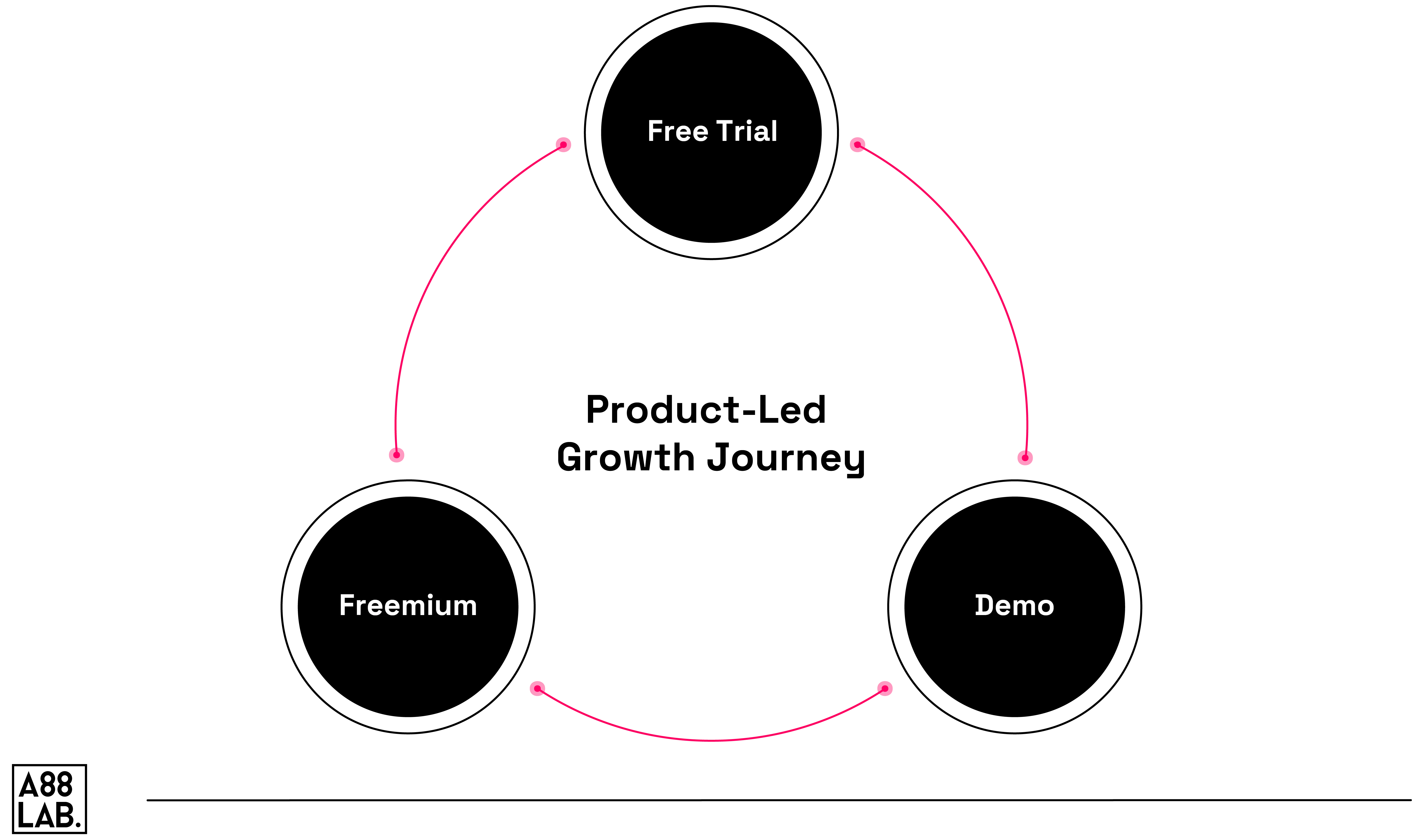
Evaluating Free Trial, Freemium, and Demo Models
A free trial is a straightforward product growth strategy, providing users with a full, hands-on experience of your product, for a limited amount of time. This allows them to explore features, functionality, and overall value, creating an immersive trial period.
A great example within a product-led growth context is Spotify’s free trial option. You only get the most basic features, e.g., listening to music, podcasts, and creating playlists. However, if you want to skip more than six songs within one hour and do not want your experience interrupted by ads, you will have to update to premium.
On the other hand, freemium involves offering a basic version of your product for free, with the expectation that users will be enticed to upgrade to premium features. For example, you can continue to use all of Canva’s tools even if you do not have a premium plan. However, you can’t access its Brand Kit features or resize templates unless you opt into the premium model.
Demo is a guided presentation where your team walks potential customers through the features and benefits of your product, offering insights and addressing queries in real-time. Salesforce is an excellent example of how to implement a demo successfully.
By building an entire demo center filled with product demo videos, Salesforce helped potential customers understand how each of their products works. When potential customers click on a solution, they are taken to a separate page that outlines the product’s benefits. The best part - no sales rep was needed during the demo.
Lastly, let's talk about interactive demos—our personal favorite. Platforms like Storylane and Navattic offer a smooth way for prospects to explore your product on their own terms, cutting out the friction of a traditional demo. If PLG is a core focus, these tools should be in your demand gen toolkit, no question.
Advantages and Limitations of Each Approach
Each model comes with its set of advantages and limitations. Free Trials offer a hands-on experience, allowing users to truly experience the product before committing. However, there's a risk of attracting users merely seeking a temporary solution without genuine interest in a long-term commitment.
Freemium, with its tempting free tier, has the potential to attract a broader audience, but converting free users into paying customers can be a challenging endeavor. Demos, providing a personalized and guided experience, offers a focused presentation of your product's value but may consume more time for both users and your staff.
Best Practices for Implementation
Striking the right balance between providing enough value to attract users and ensuring a easy pathway to conversion is key. Implementing a product-led growth strategy involves constant refinement, aligning your chosen model with the needs and expectations of your audience. The alignment contributes to a steady product-led growth journey, encouraging successful customer acquisition and satisfaction.
An important thing to keep in mind: product-led growth requires more work than simply deciding whether to offer a free trial, freemium or a demo. Once again, Wes Bush explains it perfectly:
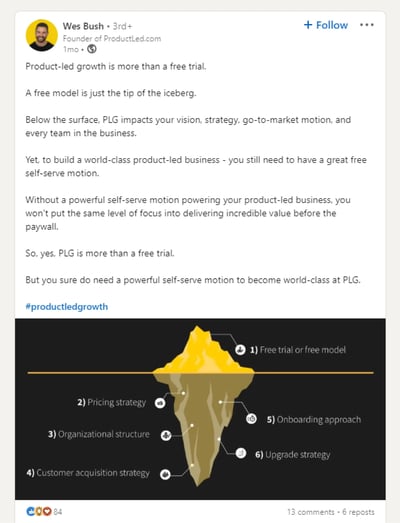
Top-Down or Bottom-Up Selling Strategy in Product-Led Growth
Product-led growth initiates a major change in traditional go-to-market strategies, causing companies to reassess their conventional sales approaches. In this segment, we will discuss top-down versus bottom-up selling strategies, and how they can drive your product-led sales.
Understanding Sales Approaches
Top-down and bottom-up sales strategies stand as major considerations in the product-led sales. The top-down approach involves precisely targeting high-level decision-makers, often executives, and compelling them with the product's unique value proposition. This demands careful preparation to tailor pitches and presentations to executive-level concerns, ensuring that the product perfectly aligns with all of your business goals.
The bottom-up approach directs efforts towards end-users, leveraging a more decentralized strategy. This facilitates viral adoption and growth as users organically share positive experiences, contributing to a wider user base. While this approach may require less upfront preparation compared to its counterpart, it presents challenges in gaining executive buy-in and aligning the product with comprehensive organizational objectives.
Integrating Sales Strategies With Product-Led Growth Models
Just because it’s a product-led growth model, it doesn’t mean that you can’t use sales strategies. While it may seem difficult to incorporate a sales strategy in a PLG context, the reward will outweigh the risk. A successfully integrated sales strategy will complement and even increase user adoption, inevitably leading to growth, and increase product-led sales.
To achieve this balance between sales strategies and product-led growth, you must first decide which strategy you will pick. If you go with the top-down strategy, your product must cater to decision-makers. In most companies, the decision-makers are C-level executives, who are inherently busy people.
Ask yourself, do busy people have time to play around with your product via a freemium model? On the other hand, the bottom-up approach is made for end-users, the people who have both the time and (usually) the will to learn on their own.
Should you choose to go with a top-down sales strategy, make sure that your user onboarding is on point. If you manage to strike a balance between being time-efficient and informative, you are good to go. Finally, if you go with a bottom-up strategy, build a solid freemium offer, so that when the end-users are done exploring, they’ll have no unanswered dilemmas and they’ll immediately opt-in to your offer.
Product-Led Growth Pricing Strategies
Pricing is usually one of the most important aspects of any business and of any strategy. That is why we’ve addressed the product-led growth pricing strategy in greater detail, which will hopefully help you make a sound decision as to which one is right for your company.
How Product-Led Growth Affects Your Pricing Models?
Within the product-led growth context, pricing plays an important role in value delivery. Unlike traditional models, where you have some wiggle room in terms of pricing, product-led growth pricing is linked to the value that the product brings to its users. The emphasis is not only on the product’s features, but also on how much value those features provide through the customer’s journey.
In the upcoming section, we’ll look into the most common pricing strategies within product-led growth. Furthermore, we'll also discuss how product-led growth affects your existing pricing models, and why they may be inadequate for this particular framework.
Common Pricing Strategies in Product-Led Growth
Without further ado, here’s a list of the most common pricing strategies in product-led growth:
- Usage-based pricing: as the name suggests, you charge the user for the actual usage of your product, meaning they aren’t obligated to pay for all of your product’s features. Usage-based pricing leads to shorter sales cycles and increased customer satisfaction but can also cause some internal issues. For example, you might have a hard time deciding on which metric you will measure the usage, and planning your annual costs can be a pain point.
- Seat-based pricing: you will charge your users based on how many of them are using your product. A pretty straightforward strategy where the more users use your product, the more money you earn. However, not everything is so clear-cut. If your product is intended for a B2B SaaS company that has only ten employees, you will have to charge them a lot more in order to scale properly.
- Active seat pricing: also known as seat-based pricing’s long-lost cousin. The only difference is that only the users who actually use the product are charged (think of Slack.) This pay-to-play method is very fair for the users, but it might give you headaches when it’s time to decide which metrics to use when charging the said users.
- Flat rate pricing: the most straightforward plan, both for you and for your users. They decide which pricing plan they will pick, and they pay that amount until they want to upgrade/downgrade. This leads to predictable costs for you, but it will also entail careful crafting of your pricing plans, something that isn’t always as fun as it might seem.
Choosing the Right Product-Led Growth Pricing Strategy
If your product is easy to use, and you can easily come up with metrics to charge the users, then feel free to go with usage-based pricing. On the other hand, if your product is intended for large-scale businesses, then seat-based pricing can be more lucrative. If you still can’t decide between usage-based and seat-based pricing, you’re in luck! Active seat pricing is ideal for products that can easily track usage.
Finally, if all of this seems like rocket science to you, and you don’t like the unpredictability that comes with not being able to forecast annual costs, then flat rate pricing is the way to go. Keep in mind that deciding on the right pricing strategy should come at the end, not at the beginning! You must first have an impeccable product before putting a price tag on it.
Mistakes and Challenges SaaS Companies Face With Product-Led Growth
s we have seen thus far, product-led growth in the B2B SaaS industry offers an abundance of opportunities for success, but it also comes with its fair share of challenges. These challenges are mistakes or pitfalls that come with the territory of becoming a product-led organization.
There are pain points that are unfortunately very prevalent, and we tried our best to outline them for you, so that you can do your best to prevent them.
Overlooking User Onboarding
If you’ve made it this far, you are familiar with the concept of user onboarding. However, we can’t stress this enough: you can’t overlook user onboarding! It’s the stepping stone to commitment by your users to your product, hopefully until death do you part. After you recognize the importance of user onboarding, it’s time to get to work.
Firstly, make sure you are armed with all of the knowledge you need to answer the user’s questions, concerns, or remarks. Then, try to make the process as intuitive as possible. While you will be there to help out the users, you shouldn’t do all the work. Your product is the one that does the selling, you are the one that does the guiding, not the other way around.
You’re still not sold on why user onboarding is so important? Watch this video:
Neglecting Continuous Product Value Assessment & Value Proposition
Another key aspect of a product-led growth strategy that we previously discussed is the product’s value proposition. This proposition is inherently tied to the product’s value, and you should never neglect its continuous assessment. Crafting a value proposition isn’t a one-time thing when it comes to product-led growth. Since the value delivery is constantly evolving, your value proposition should follow suit.
Neglecting this aspect can negatively impact your product-led growth strategy. It’s not a rare sight to see a product that flops, simply because it fails to adapt to customer needs. Your product should deliver value not just at point A and point B but also through the entire customer journey. By establishing frameworks for value assessment, you will always be on top of all issues, ensuring a value-driven user experience.
Challenges and Drawbacks of a Product-Led Growth Strategy
Like every other business strategy, the product-led growth strategy has its challenges. If you have had the impression thus far that product-led growth can do no wrong in terms of business, stick around for this part, in which we will discuss the challenges and potential drawbacks of PLG.
Managing Increased Support Demands
Implementing a product-led growth strategy may lead to an increase in customer support demands. You can do everything in your power to prep your team to answer to these demands, but sometimes, that might not cut it. While a DIY approach is always a good idea, getting a helping hand from the outside may be better.
An example of proper implementation of an external support solution to meet increasing demands is the one of Hopper. We will discuss Hopper's case in greater detail later on, but to treat you with a sneak peek, here is a quote from their Head of Customer Experience: "Don't wait until your tools prove to be inadequate and begin to impact customers. Find resilient platforms that will scale with customer needs and business growth."
Balancing User Autonomy and Company Goals
Regarding product-led growth, balancing user autonomy and company goals presents a real challenge. This challenge is oftentimes an uphill battle, but by adopting a product-led growth strategy, the hills become less steep. Suppose your company bases its goals on continuously delivering the best value for its customers. In that case, you will have an easier time striking the right balance between your goals and your customer's freedom.
How to Avoid Mistakes and Find Success in a Product-Led Growth Framework
If you adopt a product-led growth framework, you’ll need the strategic know-how to overcome potential obstacles and ensure long-term success. The next couple of sections will discuss why feedback and training are key for mitigating mistakes and ensuring success within a product-led growth framework.
Establishing a Robust Feedback Loop
When using a product-led growth framework, establishing a robust feedback loop is similar to opening a direct line of communication with users. This loop isn’t just about soliciting feedback, but it also entails creating an environment where users can approach you with their questions or concerns.
By establishing a feedback loop, you will have access to insights from users, their experiences, their unmet needs, or their advice for improvement. This two-way communication will enable you to stay on top of your game, by aligning your product with the evolving user’s needs and expectations.
A perfect example of a well-incorporated feedback loop would be the one that Linktree has. Even though their decision-making is data-informed, they still make sure to solicit customer feedback in order to improve their product. Their team has a dedicated capacity and goes out of their way to constantly seek feedback from their customers.
Investing in Comprehensive Training
User onboarding isn’t the end of the customer journey; it is merely the beginning. By recognizing the importance of user education, you will be on the right track to success in product-led growth. Whether through interactive tutorials, detailed documentation, or personalized training sessions, the commitment to user training will make sure that they will experience your product in all its glory.
Looking back at Linktree, they sure did understand the importance of onboarding and beyond! Their so-called Onboarding Wizard helps for a smooth onboarding experience, yet it still can be used after the onboarding process has been completed.
Product-Led Growth Examples in SaaS
Putting your knowledge into practice is what separates great companies from decent ones, at least in the B2B SaaS industry. We felt that this page wouldn’t be complete without showing you how PLG works in practice.
Before we wrap up, let’s look at some real-life PLG companies in the SaaS industry. These examples shouldn’t be used as the be-all and end-all of product-led growth, but they should give you a better idea of how this growth strategy works in the wild.
Product-Led Growth Example #1: Mixpanel
Mixpanel is an event analytics SaaS that tracks user interactions with web and mobile applications. Founded in 2009, they implemented a product-led growth strategy in 2021. When potential customers visit their website, organically or from paid marketing, they can find various types of high-level information about the brand.
However, there are only two paths that can lead them to conversion as customers: they can sign up and try out the app, or they can demand a live demo.
Given that the second option is a clear-cut signal that the customer is interested in starting a sales process, they are redirected to the appropriate sales team. But should they choose to sign up on their own, they can pick between an online paid plan or Mixpanel’s free tier. The free entails completing usage milestones, talking with the sales team, etc.
To make this process work from a data and analytics standpoint, Mixpanel needed two things: to track the potential customer’s journey and to analyze the appropriate data. This also coincided with the big challenge of implementing a product-led growth strategy: making use of marketing data, sales data, and product data altogether. In Mixpanel’s case, they started implementing PLG basically with the same effort as they did when building products. Their product-led growth strategy ended up looking like this:
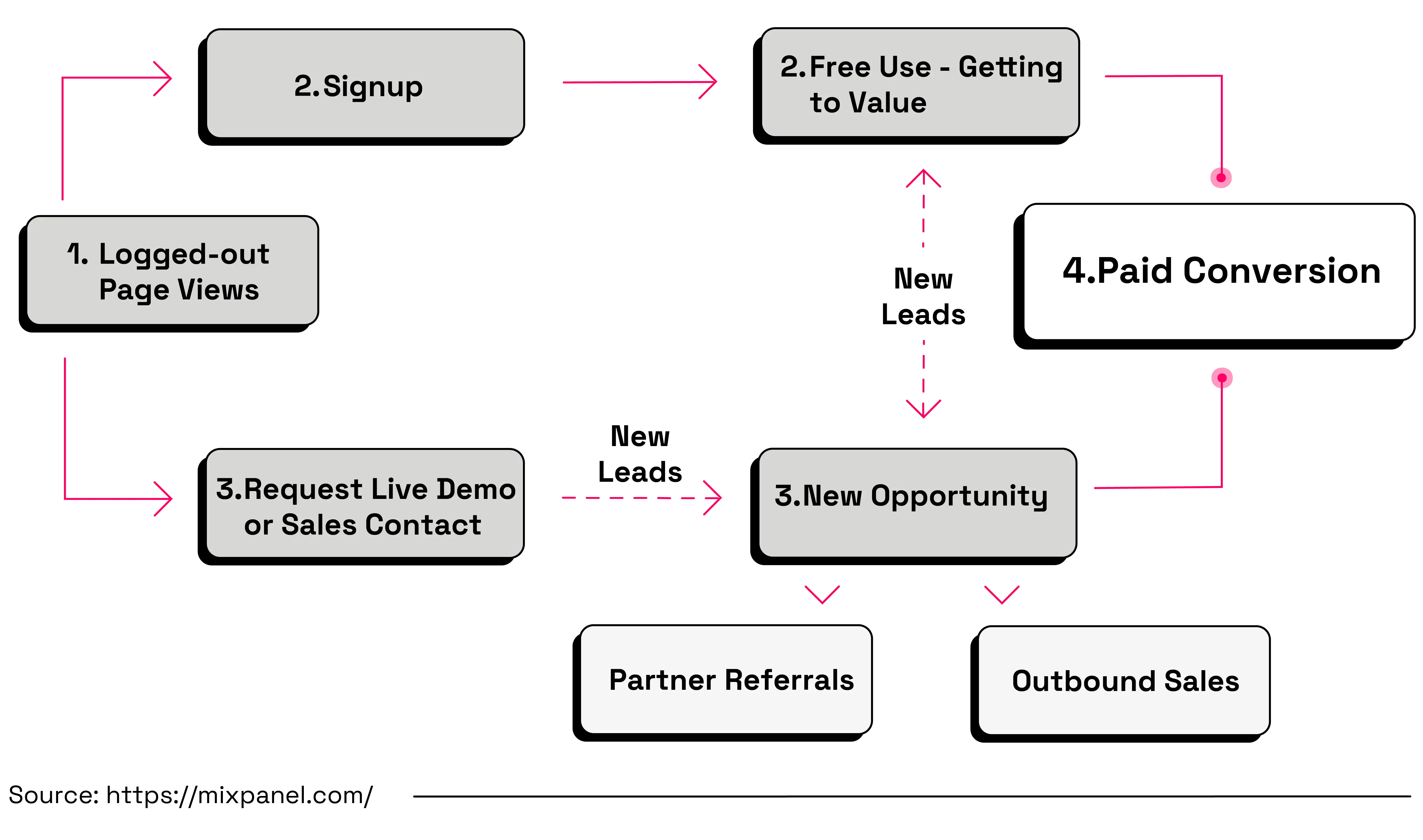
However, this product-led growth example was not always a smooth sailing process. The two primary issues Mixpanel faced when adopting a PLG strategy were identity resolution, which is the problem of tracking users and their focus across different data sources.
Mixpanel tackled the issue of identity resolution by tying together the marketing, sales, and product data through the improvement of customer identification upon signing up to the website. To improve their focus, they started by identifying their ICP and proceeded to identify “key value moments” throughout the ideal customer’s journey to maximize the value that they provide.
Thanks to sticking to the fundamentals and not neglecting the little details, Mixpanel positively impacted their company’s metrics. Their success story can be used as a product-led growth example. However, they still realize that PLG adoption is an ongoing process and that constant evaluation is required in order to provide the best value possible. The latter aspect is crucial, also evidenced in the following paragraphs.
Product-Led Growth Example #2: Klarna
Klarna, a Swedish fintech unicorn who became a juggernaut in the Buy Now Pay Later (BNPL) industry, realized early on in their work that reaching a plateau in your growth is inevitable. Once their growth started to stagnate, they doubled down on researching what they could improve in their offer. As a result, they reverted to a tried and tested product-led growth strategy: adding more value.
To start things off, they reverted to using AI in order to improve their immersive shopping experience even further. Based on your past purchases, search queries, and items in your shopping cart, Klarna curates a personalized feed for each customer. We know this does not sound revolutionary, but remember that the feed updates in real-time with a range of products and deals from various e-shops.
By implementing AI to enhance the shopping experience, Klarna becomes the starting point for every purchase. Personalization makes each user experience more relevant and valuable, inevitably leading to improved retention.
As a result of the constant value delivery, Klarna managed to become the leading brand in the BNPL industry, and the stats speak for themselves: 68% higher average order value when customers chose to spread the cost over time with Klarna and 30% of users say they only completed their purchase because of Klarna.
Product-Led Growth Example #3: Hopper
Hopper's remarkable growth can be attributed to its foray into fintech products, a move that enhanced the company's revenue and set it apart from its competitors. Hopper's marketing and user acquisition strategy focuses on product-led growth, avoiding substantial spending on Search Engine Marketing. The company's goal is to increase lifetime value and consumer retention rather than focusing solely on acquiring bookings.
The company's marketing efficiency surpasses peers, with a significantly lower spend on advertising, particularly on Google. Hopper's app-only platform contributes to organic web traffic, with 100% of its bookings made through the app.
As previously mentioned, this resulted in surges in customer demands for support, most notably during the COVID-19 pandemic. As a result, they implemented Kustomer, an AI-powered customer service platform. This undoubtedly planted the seeds for the full adoption of a product-led growth strategy.
Hopper's marketing evolution includes a move away from marketing-led growth towards product-led growth. After achieving substantial app downloads, the focus now shifts to customer retention rather than continuous acquisition. Hopper's app, downloaded over 100 million times, faced challenges sustaining growth, prompting an inward look towards product-led growth as the next opportunity.
Conclusion
In conclusion, product-led growth is the right growth marketing strategy for any B2B SaaS company that strives to offer the most value through its product.
From understanding the core tenets of PLG, to optimizing your value-delivery through the entire buyer's journey, there are many key components that you must take into consideration in order to successfully implement this strategy. However, with the right approach, focus on continuous optimization, and the right partner by your side, you can create a champion product-led growth strategy that will be successful and will breathe new life into your B2B SaaS company.
We sincerely hope that this guide has provided you with valuable insights and a better understanding of product-led growth strategy. Now, it’s your turn to put this knowledge to the test and watch your B2B SaaS company crush your goals. Best of luck! 🍀
